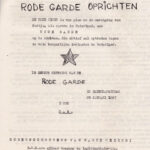Nkululeko Mabandla ~ Lahla Ngubo – The Continuities And Discontinuities Of A South African Black Middle Class
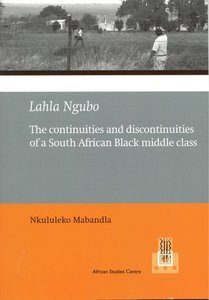 Introduction and contextual background. [This book is the winner of the Africa Thesis Award 2012]
Introduction and contextual background. [This book is the winner of the Africa Thesis Award 2012]
This work explores the role of land in Mthatha’s Black [Black is used in this thesis to refer to ‘Black African’] middle class during the apartheid and democratic eras. Mthatha’s Black middle class, which developed at the turn of the twentieth century, is a particular type of middle class that is defined not only by occupation but also by ownership of land. The path to land came about when the Mthatha municipality auctioned land to both Black and white buyers in 1908. This allowed the accumulation of land in the hands of a hitherto occupation based, mission educated Black middle class. The study traces the development of this class from the mid nineteenth century to the democratic era, and focuses on how this middle class reproduced and transformed itself during this time.
The study builds on Redding’s (1987) historical study of Mthatha (1870-1950). In addition to the first generation discussed by Redding, this study identified two more generations: A second generation which developed from the 1950s onwards, and their descendants, the third generation, which continues to combine occupation and landownership to date.
The role of land in the definition of the Black middle class is sorely missing from studies of this class in the democratic period. Recent studies have drawn attention to the growth of this class in post-apartheid South Africa. This growth was supported by employment policies such as affirmative action (AA) and Black economic empowerment (BEE). Studies have generally focussed on income/occupation as the main determinants of middle class location (e.g., Udjo 2008; Unilever Institute 2007; Rivero et al. 2003). Thus, Rivero et al. (2003) analyse the advances made by Black South Africans in the managerial and professional categories between 1994 and 2000. Their sole criterion for identifying membership in the Black middle class is occupation. Meanwhile, Unilever’s much publicised ‘Black Diamond Study’ (Unilever Institute 2007) deals almost exclusively with consumption patterns of Black professionals, that is, their affluence based on income. And indeed, much interest has been generated in the popular press, where the Black middle class is often portrayed as ‘young and driving a BMW’ (Carrol 2004).
While the new Black middle class might have considerable disposable income, it seems to lack investment in more durable assets such as property. Studies of residential mobility suggest that home ownership, for example, remains relatively low within the ‘new’ Black middle class (Beavon 2000; Prinsloo & Cloete 2002; Crankshaw 2008). The general absence of property within this class has led Southall (2005: 1) to compare it with the proletariat:
The ‘new middle class’, which is typically in government and corporate employment, shares many of the characteristics of the classic proletarian, notably in the sense that it has no direct ownership of the means of production and is in a subordinate relationship to capital owning employers.
Read more
Pascal Touoyem ~ Dynamiques de l’ethnicité en Afrique. Éléments pour une théorie de l’État multinational
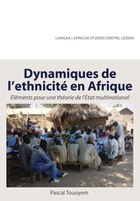 Introduction ~L’anthropologie politique et philosophique comme réflecteur herméneutique principal des structures et dynamismes fondamentaux de l’Afrique noire moderne.
Introduction ~L’anthropologie politique et philosophique comme réflecteur herméneutique principal des structures et dynamismes fondamentaux de l’Afrique noire moderne.
Le projet épistémologique qui nous habite, est déterminé par deux considérations théoriquement distinctes mais pratiquement imbriquées : à savoir d’une part la nature problématique du domaine d’étude et d’action qu’est l’ethnicité et d’autre part, l’historique exceptionnelle ou marginale de l’objet Afrique. En s’interrogeant en sens inverse sur l’affirmation de Spinoza d’après laquelle l’ordre et la connexion des idées est le même que l’ordre et la connexion des choses, nous voudrions d’entrée de jeu, attirer l’attention sur le présupposé théorique d’après lequel l’ethnicité, comme objet de recherche ne participe pas du domaine des données consacrées et légitimées de la recherche en Afrique. Cette disposition de l’attention scientifique dominante est dans une large mesure en rapport de complicité avec la doxa. Le silence et partant l’interrogation ou l’absence de réflexion sur l’ethnie et/ou la tribu tels que cristallisés au fil du temps sont loin d’être neutres. Ce silence correspond à l’émergence des savoirs dits indigènes, autochtones ou encore hétérodoxes. Ce contexte est marqué d’une part, par le reflux des doctrines de l’émancipation, héritage des luttes nationales de libération et d’autre part, par l’affirmation des théories postcoloniales depuis la fin des années 1960. D’inspiration postmoderne, les théories postcoloniales ont emprunté leurs outils heuristiques et méthodologiques aux Subalterns et aux Cultural Studies. C’est l’éclatement des cadres analytiques de la modernité, qu’il s’agisse de l’ethnicité, de l’identité, de l’Etat, de la nation, de la citoyenneté, de la production des savoirs interculturels ou encore de l’universalisme alias mondialisation qui a suscité un vif intérêt pour le « monde d’en-bas ».
Notre démarche est guidée par la conviction qu’il ne faut point négliger le « monde d’en bas » qui est le lieu pertinent où l’on peut observer l’Afrique en mouvement aujourd’hui. Une Afrique qui, en marge des grands discours prophétiques sur son effondrement, ses crises, toutes les catégories pathologiques par excellence,…construisent des formes de transactions informelles et neuves, malmenant les civilités conventionnelles et officielles, mais qui justifient la perdurance sociale. Derrière les métamorphoses de la désintégration sociale et de l’anarchie, une vie sociale et créative se poursuit en Afrique. Un tableau complexe de la vie culturelle est entrain d’émerger. Des formes reconnaissables de développement coexistent avec des trajectoires originales de création ; des conceptions identitaires naissent ou se sont reformulées. Arc-boutée à une immense réserve d’endurance et d’imagination et portée par une extraordinaire puissance de résistance, contre la brutalité du destin, l’Afrique est au travail. Ni la prodigieuse singularité de l’expérience humaine en Afrique, ni les nouvelles formes d’engagement du marché avec les politiques internationales ne peuvent être restituées à partir des catégories et discours traditionnels. Plus que jamais, il faut une nouvelle stratégie de description et d’interprétation de nouvelles façons de percevoir ces réalités, de nouvelles catégories d’expression des potentialités et surtout un nouveau discours pour décrire l’Afrique et dépeindre les expériences et les souvenirs de ceux ou de celles qui sont au centre de ces transformations.
C’est donc à une objectivation plus approfondie de la dynamique anthropo-sociale et politique de la modernité négro-africaine que voudrait s’essayer la présente étude. Le titre éponyme de cette étude : « Eléments pour une théorie de l’Etat multinational », nous permet de scruter les diverses modalités de la cohabitation inter-ethnique en Afrique noire. Il est question de ressortir les lieux, les niveaux, les questions et les diverses médiations institutionnelles de la crise de l’ethnicité dans l’institution étatique elle-même en crise en Afrique. L’enjeu c’est de dégager désormais une sorte d’exploration, au sens de Balandier, des territoires de la socialité en Afrique, de les rendre descriptibles et intelligibles, afin de s’initier à la découverte de l’inédit. Le « fait ethnique », caractéristique des sociétés africaines, fait l’objet d’un silence épistémique néfaste. Ce silence, au niveau de la production des savoirs interculturels constitue pour nous, un obstacle quasi-infranchissable en même temps qu’il se présente comme la source de notre détermination. On ne peut tenter une telle étude sur les enjeux anthropologiques et épistémo-politiques des structures et dynamismes fondamentaux de l’Afrique noire, sans esquisser un inventaire de l’état des lieux. C’est une vieille démarche aristotelicienne qui recommande, pour chaque question, d’explorer sa topique, autrement dit l’ensemble de ses lieux communs.
Read more
Marc-Antoine Pérouse de Montclos ~ Boko Haram: Islamism, Politics, Security And The State In Nigeria ~ Introduction And Overview
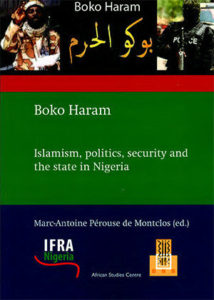 Introduction and Overview
Introduction and Overview
As I write this introduction in November 2013, Boko Haram is making the headlines. Paradoxically, it is seen in the media as clandestine and invisible, according to Nigerian President Goodluck Jonathan, who said he would not negotiate with “ghosts”. The sect of Mohammed Yusuf was not always famous, however.
When I began to investigate the so-called Taliban on the Niger–Nigeria border in 2005, no academics had written anything on Boko Haram. At that time, security analysts focused on violence in the oil-producing Niger Delta, and very few paid attention to a marginal group of extremists in remote Borno and Yobe states.
Since then, the sect has become a fashionable topic of research as well as an international issue. More so than the Maiduguri uprising of July 2009, the attack on the UNDP office in Abuja in August 2011 attracted much attention. Thus a considerable number of articles on Boko Haram are now being written in the field of security studies. Many of them speculate on an Al-Qaeda franchise in Nigeria and possible links with AQIM (Al-Qaeda in Islamic Maghreb) in Mali.[i]
Some even suggest that the US should fund the Qadiriyya and Tijaniyya brotherhoods to counter radical Islamism (Hill 2010). Such articles are oriented towards policy making. Accordingly, they make recommendations on the way to fight terrorism in the Nigerian context (see for instance Waldek & Jayasekara 2011; Aghedo & Osumah 2012; Forest 2012; Onuoha 2012; Idowu 2013; Sampson 2013). But they do not investigate Boko Haram from a political, sociological, religious, and anthropological academic perspective.
Hence the necessity for a different type of analysis. Written by Nigerian, French, British, German, and American contributors, this book is the first of its kind. It not only offers different perspectives from northern and southern Nigeria, but also combines fieldwork and theory, qualitative and quantitative analysis.
Moreover, it is not just another monograph study on Boko Haram. Rather, the following chapters investigate how radical Islamism destabilises the Nigerian state and challenges its secularity. In a pluralistic society, the jihad of Boko Haram raises many fears regarding Shariah, freedom of religion, the clash of civilisations, and the prospect of a civil war with Christians. Yet all these issues are usually oversimplified in the rhetoric of the war on terrorism.
Shariah, for instance, is a whole way of life for Muslims. It should not be reduced to criminal law. Likewise, jihad is first and foremost an internal spiritual struggle, rather than a holy war against Christians (Cruise O’Brien & Coulon 1988; Westerlund & Rosander 1997; Levtzion & Pouwels 2000; Vikør 2005; Soares 2007; Hefner 2011). As for freedom of religion, it is often understood by legal practitioners as a right to follow a rite, to preach, to express religious beliefs in public and, more generally, to be allowed to build a church, a mosque, or a temple.
Read more
Goede, M.de ~ Consuming Democracy: Local Agencies & Liberal Peace In The Democratic Republic Of Congo
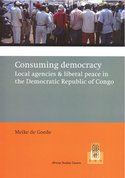 This thesis is about democratisation as a central pillar of liberal peace building in the Congo and focuses on Parliament and parliamentarians in this process. The picture above captures many of the themes that will be discussed in the chapters that follow: that of the interaction between Members of Parliament (MPs) and their electorate, the self-perception and popular perception of MPs in the Congo, and the roles of MPs as providers that redistribute. The picture shows a painting made by a popular artist from Kinshasa that criticises MPs and by extension Parliament as an institution. When I bought it the painter explained to me what he intended to express by this image. ‘Kuluna en cravate’ is a reference to MPs used by Kinois and refers to the recent phenomenon of Kuluna, violent and thieving youth gangs. The MP is a Kuluna in a tie (cravate). He gives money to some people. He has three ladies by his side, ‘because he is very rich’, and the media is present to record his well doing and expose the MP as a provider for the people. But the painter also expressed a critical reflection on these practices by mockingly referring to the MP as a Kuluna in a tie. Although the MP appears to do something for the people, he has in fact stolen his wealth from the people and he is acting against them (contre la population congolaise).[i]
This thesis is about democratisation as a central pillar of liberal peace building in the Congo and focuses on Parliament and parliamentarians in this process. The picture above captures many of the themes that will be discussed in the chapters that follow: that of the interaction between Members of Parliament (MPs) and their electorate, the self-perception and popular perception of MPs in the Congo, and the roles of MPs as providers that redistribute. The picture shows a painting made by a popular artist from Kinshasa that criticises MPs and by extension Parliament as an institution. When I bought it the painter explained to me what he intended to express by this image. ‘Kuluna en cravate’ is a reference to MPs used by Kinois and refers to the recent phenomenon of Kuluna, violent and thieving youth gangs. The MP is a Kuluna in a tie (cravate). He gives money to some people. He has three ladies by his side, ‘because he is very rich’, and the media is present to record his well doing and expose the MP as a provider for the people. But the painter also expressed a critical reflection on these practices by mockingly referring to the MP as a Kuluna in a tie. Although the MP appears to do something for the people, he has in fact stolen his wealth from the people and he is acting against them (contre la population congolaise).[i]
Liberal peace building in the Democratic Republic of Congo
Liberal peace building in the Democratic Republic of Congo (DRC, the Congo) started after the signing of the Sun City Peace Agreement (2002). The 2006 general elections marked the end of a transitional period and in November 2011 the Congolese electorate went to the ballot box to elect a President and Parliament for the second time. Until then, results of liberal peace building interventions in the Congo have been disappointing and discouraging. Nearly a decade of peace building has had a limited impact on people’s daily lives. Freedom House consistently ranks the Congo as ‘not free’ with political rights and civil liberties marked six out of seven (one being most free and seven being the most unfree). In 2011, the country was ranked as one of the most corrupt countries in the world and has sunk to the bottom of the Human Development Index.[ii] During the first term of his Presidency, Kabila has firmly established his regime and taken control over the state and its institutions. This has on the one hand brought some stability after the turbulent past decades, while on the other hand it has been cause for concern. People feel that the regime is developing dictatorial tendencies. It swallows all power and leaves little space neither for the opposition nor for state institutions such as the courts or the security forces to be non-partisan. Particularly in the pre-electoral period of 2011 the Kabila regime has shown a concerning side of itself, that of violence, and intimidation, and sometimes magnificent strategies of political and electoral manipulation. Within five years after the celebration of the country’s first elections as the launch of a new democratic era for the country people already speak of a return to ‘Mobutism-without-Mobutu’. The country is as corrupt as ever, the state is malfunctioning and there are little signs of any improvement. The armed forces continue to be a source of insecurity to an already battered population, and poverty and human suffering aggravates instead of reduces. The liberal peace seems to have derailed and lost its momentum, right under the noses of its agents (the donor community, the international community), and with their financial support.
The liberal peace is founded on the idea that liberal market democracy fosters domestic and international peace. Political and economic liberalisation is therefore employed as a means to end and prevent violent conflict (Paris 2004, 40-42). It thus ‘combines and conflates’ democracy with peace. This has resulted in a project of social transformation which aims to transform dysfunctional societies into peaceful societies by including them in the liberal world order (Duffield 2001, 11). This project of social transformation comes in different graduations – conservative, orthodox, emancipatory – reflecting graduations in the balance between coercion, top-down intervention and externalisation on the one hand, and local ownership, bottom-up peace building, consensus and social justice on the other (Richmond 2005, 214-15). Liberal peace building involves democratisation and liberal market reform (Richmond 2006, 292). This thesis is concerned with post-war democratisation in the Congo, as one of the central pillars of liberal peace building. Democratisation in liberal peace building terms prioritises a rights based approach which focuses on elections, the institutions of democratic governance, civil society building, the rule of law, and human rights. This thesis focuses on the Congolese National Parliament as a site of democratisation. Although democratisation as part of liberal peace building in the Congo only started after the signing of the 2002 peace agreement, the efforts for democratisation in the Congo date back more than 20 years. The past two decades have been extremely volatile in the Congo. In the early 1990s Mobutu’s dictatorial regime crumbled and a process of political change towards democracy was launched.
Since then the Congolese population has been awaiting elections, while undergoing various phases of democratisation. They were insecure and turbulent times. The democratic transition of the 1990s failed eventually and was overtaken by a civil war. The first Congolese war (1996-7) had its origins in the disintegration of the Zaïrian state, the genocide in neighbouring Rwanda followed by a security crisis in Zaïre and the inability of the Mobutu regime to respond adequately to these developments. Under these conditions of weakness of the state, the challenges posed by the crisis in neighbouring Rwanda easily spilled over to Zaïre to become a Zaïrian crisis. With support from Rwanda and Uganda, an alliance of four rebellion or opposition parties known as the Alliance des Forces Armées pour la Libération du Congo (AFDL), under the leadership of Laurent-Désiré Kabila, launched a successful war against Mobutu in September 1996, accessing power on May 17 1997. However, it was not long before the Kabila coalition fell apart. In August 1998 a new war was launched by RCD (Rassemblement Congolais pour la Démocratie), a new rebel movement with the support of Rwanda, shortly followed by MLC (Mouvement pour la Libération du Congo), which was supported by Uganda. The Second Congolese war involved many neighbouring countries. While Uganda and Rwanda were fighting on the anti-Kabila front, Angola, Zimbabwe, Namibia and Chad continued to support Kabila. On the side of the resistance another three movements developed in due course: RCD-K/ML (Kisangani/Mouvement de Libération) (also backed by Uganda) and RCD-N (National) split away from what now became known as RCD-Goma. In addition, the Mai Mai, groups of armed fighters that have existed since the 1960s, became involved in the war, as well as various rebel movements from neighbouring countries that were operating from in the Congo. In addition, several African countries sent their armies in support of Kabila’s regime. Within a short period of time, the war had become a complex patchwork of armed rebellions and foreign armies roaming around Congo.
Full text (PDF): https://openaccess.leidenuniv.nl/ASC-075287668-3597-01.pdf?sequence=2
Notes
[i] Author’s conversation with artist, Kinshasa 23 July 2011.
[ii] www.freedomhouse.org; http://cpi.transparency.org/cpi2011; http://hdr.undp.org.
Thesis published in 2015 ~ ISSN: 1876-018x ISBN: 978-94-6173-720-5
Piet Konings & Francis B. Nyamnjoh ~ The Anglophone Problem In Cameroon
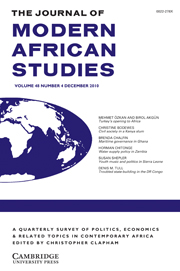 The Journal of Modern African Studies, 35, 2 (1997), pp. 207–229. – Printed in the United Kingdom. © 1997 Cambridge University Press
The Journal of Modern African Studies, 35, 2 (1997), pp. 207–229. – Printed in the United Kingdom. © 1997 Cambridge University Press
The political agenda in Cameroon has become increasingly dominated by what is known as the ‘anglophone problem’, which poses a major challenge to the efforts of the post-colonial state to forge national unity and integration, and has led to the reintroduction of forceful arguments and actions in favour of ‘federalism’ or even ‘secession’.
The root of this problem may be traced back to 1961 when the political élites of two territories with different colonial legacies – one French and the other British – agreed on the formation of a federal state.[i] Contrary to expectations, this did not provide for the equal partnership of both parties, let alone for the preservation of the cultural heritage and identity of each, but turned out to be merely a transitory phase to the total integration of the anglophone region into a strongly centralised, unitary state. Gradually, this created an anglophone consciousness: the feeling of being ‘marginalised’, ‘exploited’, and ‘assimilated’ by the francophone-dominated state, and even by the francophone population as a whole.
It was not until the political liberalisation process in the early 1990s that some members of the English-speaking élite started openly to protest against the supposed subordinate position of the anglophones and to lay claims for self-determination and autonomy. Whereas the most important organisations initially called for a return to the federal state, the persistent refusal of the Government headed by President Paul Biya to discuss any related constitutional reforms forced some to adopt a secessionist stand. They attempted to gain international recognition for their demands through a diplomatic offensive that presented the anglophones as an oppressed minority whose territory had been ‘annexed’ by the francophone-dominated state. The Government has not surprisingly devised various strategies to safeguard the unitary state, including attempts to minimalise or even deny the existence of an ‘ anglophone problem’, to create divisions among the English-speaking presented the anglophones as an oppressed minority whose territory had been ‘ annexed’ by the francophone-dominated state. The Government has not surprisingly devised various strategies to safeguard the unitary state, including attempts to minimalise or even deny the existence of an ‘ anglophone problem’, to create divisions among the English-speaking élite, to remunerate some allies with prestigious positions in the state apparatus previously reserved for francophones only, and to repress all actions designed to change the status of the Southern Cameroons.
The Constitutional Background
The birth of the Federal Republic of Cameroon on 1 October 1961 marked the reunification of two territories which had undergone different colonial experiences after World War I,[ii] when the erstwhile German Kamerun Protectorate was partitioned between the British and the French, first as ‘mandates’ under the League of Nations and later as ‘ trusts’ under the United Nations.[iii] It needs to be recalled that part of the British mandate}trust territory, which came to be called Southern Cameroons, was initially attached to the Eastern Provinces of Nigeria until 1954, when it achieved a quasi-regional status and a limited degree of self-government within the Federation of Nigeria, where it attained full regional status in 1958. There can be no doubt that the administration of Southern Cameroons as an appendage of Nigeria resulted in the blatant neglect of its development,[iv] as well as the dominant position of Ibo and Efik-Ibibio migrants in its economy.
It was Southern Cameroons which voted in the 1961 United Nations plebiscite for reunification with French Cameroun rather than for integration into Nigeria.[v]
Download paper (PDF): https://openaccess.leidenuniv.nl/ASC-1246231-023.pdf?
* Piet Konings is Senior Researcher at the Afrika-Studiecentrum, Leiden, and Francis Nyamnjoh is Senior Lecturer at the University of Buea, Cameroon.
Notes:
[i] Other scholars trace the genesis of the anglophone problem in Cameroon to World War I. According to Nicodemus Awasom, ‘The Development of Autonomist Tendencies in Anglophone Cameroon, 1960–61’, the unequal partition of the country between France and Britain, following the defeat of Germany in West Africa in 1916, ‘sowed the seeds of future problems’ in that this accounted for ‘ the ultimate emergence, in a reunified Cameroon, of an anglophone minority and a French majority’.
[ii] See, for instance, Willard R. Johnson, The Cameroon Federation: political integration in a fragmentary society (Princeton, NJ, 1970); Victor T. Le Vine, The Cameroon Federal Republic (Ithaca and London, 1971); and Jacques Benjamin, Les Camerounais occidentaux : la minorité dans un état bicommunautaire (Montreal, 1972).
[iii] See Edwin W. Ardener, ‘The Political History of Cameroon’, in The World Today (London), 18, 8, 1962, pp. 341–50; David E. Gardinier, Cameroon : United Nations challenge to French policy (Oxford, 1963); Victor T. Le Vine, The Cameroons : from mandate to independence (Berkeley and Los Angeles, 1964); and Richard A. Joseph, Radical Nationalism in Cameroun : social origins of the U.P.C. rebellion (Oxford, 1977).
[iv] According to Paul M. Kale, Political Evolution in the Cameroons (Buea, Government Printer, 1967), pp. 12-13, Britain’s administration prior to World War II was ‘haphazard and full of misgivings’, provoked by ‘ an apparent lack of administrative interest’ which he thinks was due to ‘ the fear that Germany might suddenly demand a return of her former African possessions’. For this reason, Britain might have thought it ‘preposterous spending, and possibly wasting, British taxpayers’ money and talent on what was not, strictly speaking, a developing British country’. From Le Vine, op. cit.1964, pp.194–201, we gather that Whitehall often regarded Southern Cameroons ‘as somewhat of a colonial liability’, administered all the way from Lagos, with hope of its ‘eventual integration with Nigeria’. It had neither a separate budget nor separate public accounts; all its government revenues were treated as part of a common fund.
[v] Concerning reunification, it is worth noting that in spite of a ‘popular’ disinclination for an ‘early reunification after secession from Nigeria’, the UN never gave the people that option. Also, the boundaries of the reunified territory ‘were not willed by those who wished for reunification’,but were imposed on them; consequently, they were much narrower than they would have been ‘if a simple reconstruction of German Kamerun had been achieved’. See Edwin W. Ardener, ‘The Nature of the Reunification of Cameroon’, in Arthur Hazlewood (ed.), African Integration and Disintegration (Oxford, 1967), pp. 285–337.
Silverlining Africa – From Images Of Doom And Gloom To Glimmers Of Hope
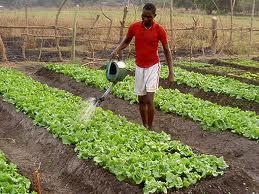 1. Changing images of the Dark Continent
1. Changing images of the Dark Continent
Inaugural address
At a recent African Studies Association conference in San Francisco, I presented a paper on the findings of a research project that I was involved in over the last few years on Ghanaians in Amsterdam and their ‘good work back home’.[i]
The theme of the conference was ‘African Diaspora and Diasporas in Africa’ and our panel was entitled ‘Development from Abroad’. Panel members presented numerous success stories from many parts of the continent and the general reaction at the conference was one of surprise at the many positive stories coming out of Africa. One of the participants in my panel talked about ‘silverlining Africa’ – stories that challenge past images of doom and gloom.[ii]
Just before going to the US, I chaired a session at the annual meeting of the Netherlands-African Business Council in a beautiful conference centre in Wassenaar where close to two hundred Dutch entrepreneurs shared enthusiastic accounts of their activities in Africa. The overall impression was that Africa is taking off and is the newest group of emerging economies to be knocking on the door of the global market. There is a political and business confidence in Africa today that reminds older observers of the euphoria during Africa’s Independence Era fifty years ago. Africa is now the place to be and certainly not a place to avoid. The organizer of the event[iii]more or less suggested that Dutch entrepreneurs would be crazy not to invest in and trade with Africa. Discussing the changes in the current Dutch development landscape, there was an almost triumphant attitude among the participants: ‘now it is our turn to eat’.[iv] But they also tried to be honest and straightforward: the new business opportunities need to be used in socially responsible, fair and sustainable ways. For some, Africa may appear to be a place where quick and dirty money can be made. For most entrepreneurs, the idea is that there are major opportunities here but that these can only be harvested with long-term commitment and involvement.
A month earlier when I was in China giving a lecture, my hosts arranged for me to visit the EXPO grounds in Shanghai.[v] I was particularly interested in the way Africa presented itself there. With a few exceptions,[vi] the African countries were housed under one roof in a huge exotic building bustling with chaotic activity. The sensual African dances and the loud drumming attracted many Chinese visitors, who were amazed by so much public indecency. The African market stalls were popular although there were Chinese-language banners strictly warning customers not to buy illegal fare and English-language signs with warnings about not taking pictures. EXPO’s title was ‘Better City, Better Life’, but a Chinese advisor who had been involved in the early support for the African pavilion told me that the Africans were not very keen on sticking to the general theme. Many of the African pavilion organizers had instead decided to show rural Africa as a paradise for tourists and investors with traditional scenes of Africa’s exotic nature and people, and as a continent full of resources to exploit. It was amusing to see that the Chinese positioned Africa as ‘the hottest place under sunlight’, even suggesting that this was the origin of the name ‘Africa’.[vii]
Read more


